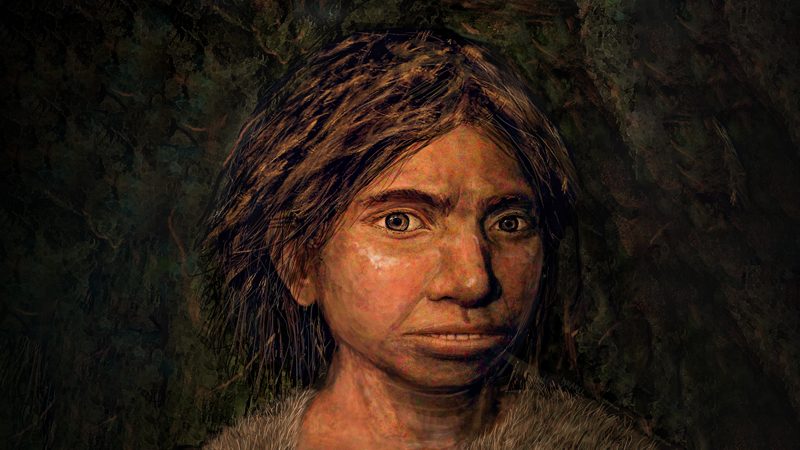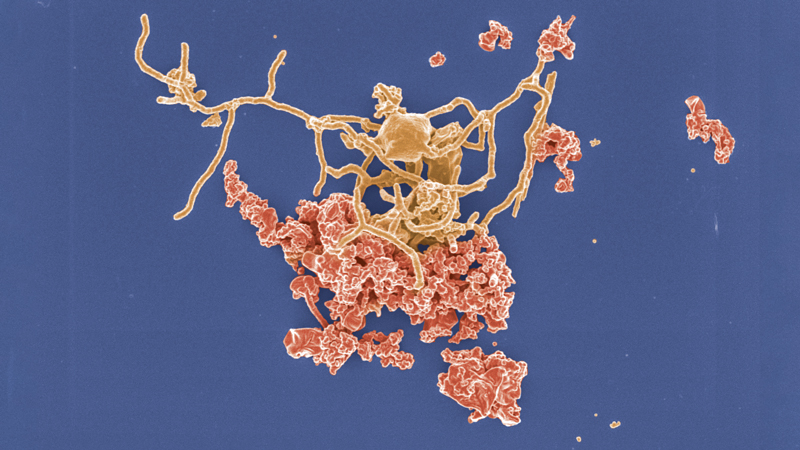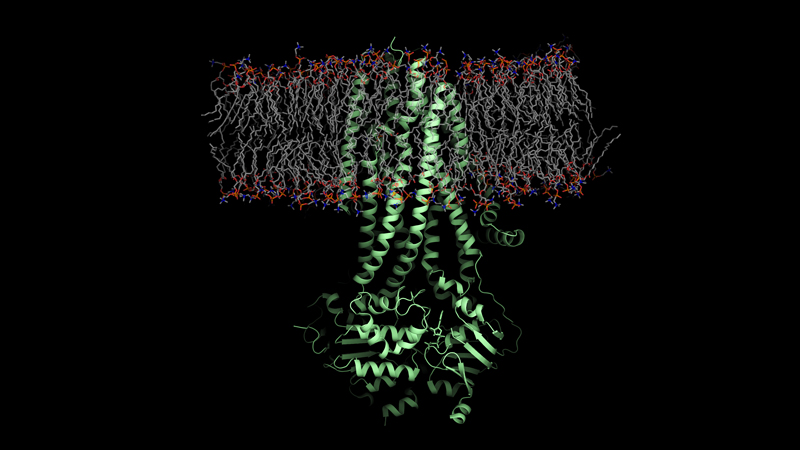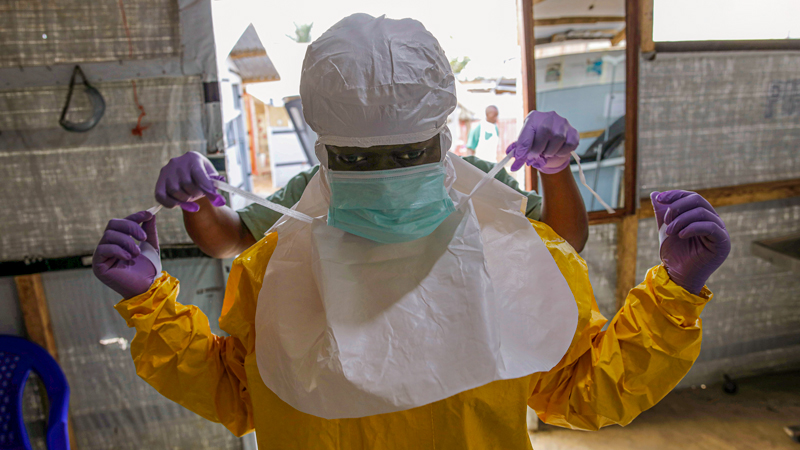Sign up for our daily newsletter
Get more great content like this delivered right to you!
Required fields are included by an asterisk(*)
An international team of astronomers has produced the first ever image of a black hole

A simulation of matter swirling around the black hole at the center of Messier 87 and radiating at different wavelengths. A bright ring of light orbiting the black hole’s shadow shines through the haze, and green tendrils of a powerful jet stream from its pole.
Massive, ubiquitous, and in some cases as big as our Solar System, black holes hide in plain sight. The effect of their gravity on objects around them and, lately, the gravitational waves emitted when they collide reveal their presence. But no one had ever seen one directly—until April. That’s when an international team of radio astronomers released a startling close-up image of a black hole’s “shadow,” showing a dark heart surrounded by a ring of light created by photons zipping around it. Heino Falcke of Radboud University in Nijmegen, the Netherlands, a member of the team that produced the image, said the first glimpse felt like “looking at the gates of hell.” That evocative image is Science’s 2019 Breakthrough of the Year.
For astronomers, the image is a validation of decades of work theorizing about esoteric objects they couldn’t see. “I’m still kind of stunned,” says astrophysicist Roger Blandford of Stanford University in Palo Alto, California. “I don’t think any of us imagined the iconic image that was produced.” In fact, until recently few astronomers imagined such an image was even possible. Black holes are very small by cosmic standards and by definition emit no light. When they grow to gargantuan masses, as happens in the centers of galaxies, the swirling mayhem of gas, dust, and stars stirred up by their extreme gravity creates an additional barrier.
But 2 decades ago, a handful of astronomers began to wonder whether the hot swirling gases close to a giant black hole’s edge, or event horizon, might make it visible. They glow at many wavelengths, including millimeter waves—short-wavelength radio waves that can pierce the gas and dust surrounding a galactic center. Developments in technology promised to help. A technique known as very-long-baseline interferometry (VLBI), which combines data from widely spaced radio dishes to simulate a much larger telescope, was revealing distant objects in finer detail. And improvements in receivers, antenna design, and digital electronics were allowing radio astronomers to capture millimeter waves. By observing at those wavelengths, using dishes spread as far apart as possible to boost resolution, could they make out the details of a black hole?
Maybe, if it were a monster with the mass of millions of suns, and relatively close by. The 4-million-solar-mass black hole at the center of our Milky Way Galaxy, known as Sagittarius A* (Sgr A*), was an obvious contender, being the closest to Earth at just 26,000 light-years away. Despite its heft, it is a tiny object in galactic terms—it would fit inside the orbit of Mercury—and imaging it would push VLBI to the limit.
Early attempts about a dozen years ago using telescopes in Hawaii and the mainland United States revealed scraps of detail of the superheated gas close to Sgr A*. The telescopes also got a glimpse of a second potential target: the supermassive black hole at the center of the nearby galaxy Messier 87. Although M87 is 2000 times farther from Earth than Sgr A*, its black hole, M87*, has more than 1000 times the mass so it appears roughly the same size in the sky. With observations beginning to bear fruit, funding agencies started to chip in, and the international Event Horizon Telescope (EHT) was born.
Despite its name, EHT is not a telescope, but a consortium involving more than 200 scientists from across the globe. It applies for time on existing telescopes—as many and as widely spaced as possible. At most telescopes, EHT members must install their own equipment, including high data rate digital processors and atomic clocks, to make the instrument VLBI-friendly. A turning point came when EHT enlisted the Atacama Large Millimeter/submillimeter Array (ALMA). Made up of 66 dishes high in the desert mountains of northern Chile, it is by far the largest observatory at millimeter wavelengths. Allowing the EHT team to come in, open up the hood, and tinker with the engine of this $1.5 billion U.S.-European-Japanese collaboration took years of persuasion and several rejected designs, but adding ALMA boosted EHT’s sensitivity 10-fold.

The iconic image of galaxy Messier 87’s central black hole, showing a ring of photons bent by its gravity.
In April 2017, everything was in place for a major 10-night observing run. ALMA, along with seven other observatories in the United States, Mexico, Chile, Spain, and at the South Pole, took repeated nightlong exposures of both Sgr A* and M87*. “We lucked out with the weather,” says EHT’s founding director Shep Doeleman of the Harvard-Smithsonian Center for Astrophysics in Cambridge, Massachusetts. But it would be almost 2 years before the EHT team knew what, if anything, it had achieved.
Working in parallel at data centers in Germany and the United States, separate teams calibrated and processed the data, using several different methods, while other teams independently checked the results. No image was produced until the very end, to avoid biasing the outcome. The teams began to work on Sgr A* and M87* in parallel, but focused on M87* when they found that the material swirling around Sgr A* changed by the hour, blurring the image. The action around the giant M87* moves at a stately pace, changing little over the course of a night. In April, the team revealed an image of M87*. The black hole’s silhouette—outlined in a ring of light—adorned front pages and news reports across the globe, and became the most downloaded image in the history of the National Science Foundation’s website. A description of the effort and its implications filled six papers in Astrophysical Journal Letters.
For black hole theorists, that first, rather blurry image sprang few surprises, but just seeing it was “a glorious affirmation of theory,” Blandford says. Albert Einstein’s description of gravity, general relativity, predicts a black hole’s shadow should be perfectly round—a prediction confirmed to within 10% by the M87* image. That may rule out a few of the wildest alternative theories of gravity that aim to supplant relativity, but the EHT team will need to squeeze down the error bars in future observations to put Einstein to more stringent tests.
The best tests of general relativity could come from an image of Sgr A*, which the team hopes to finish in 2020. Researchers have much more precise data on the mass, size, and distance of Sgr A* than of M87*. “That will immediately improve the quality of constraints [on general relativity],” says team member Feryal Özel of the University of Arizona in Tucson. First, though, the team needs to sharpen its view of Sgr A*. “We’re trying to finalize the analysis tools to deal with its quirkiness,” she says.
EHT has 11 facilities lined up for the next round of observing in 2020, including new dishes in Greenland and Arizona and an upgraded array in France. Observations will soon move to even shorter wavelengths—0.86 millimeters instead of the 1.3 millimeters used so far. Further in the future, the team hopes to add a dozen or so purpose-built dishes scattered across the globe and some in space, to increase the resolution still further. A dish one-third of the way to the Moon, for example, would bring another 20 supermassive black holes into imaging range.
Such expansion would also enable EHT to graduate from making still images to “movies” of a black hole sucking in material and funneling it into high-powered jets that fire from its poles millions of light-years into space. How those jets are created “is the big astrophysical puzzle,” Blandford says. This year’s triumph, he adds, “is the beginning, not the culmination, of this research project.”
ReferencesS. Doeleman, Focus on the First Event Horizon Telescope Results, The Astrophysical Journal Letters, April 2019
C. Goddi et al., First M87 Event Horizon Telescope Results and the Role of ALMA, The Messenger, Vol. 177, Quarter 3, p. 25, 2019
H. Falcke et al., Viewing the Shadow of the Black Hole at the Galactic Center, The Astrophysical Journal Letters, Vol. 528, p. L13, 7 December 1999

This artist’s reconstruction of a Denisovan girl from Siberia is based on a new way to infer physical features from DNA.
Almost 40 years ago, a Buddhist monk found an odd human jaw bone in Baishiya Karst Cave, high on the edge of the Tibetan Plateau. Recognizing that the jaw, with its giant molars, was something special, he gave it to another monk, who donated it to scholars. But no one knew what to make of it. Then in May, scientists applied a new method of analyzing ancient proteins and identified the strange jaw as that of a Denisovan, a mysterious human ancestor who ranged across Asia until some 50,000 years ago, about the same time as the Neanderthals. The work brings these enigmatic ancient people into focus, and heralds a potential protein-based revolution in understanding ancient life.
The Denisovans have haunted human evolution researchers for 10 years. Back in 2010, researchers identified them by sequencing DNA from a fossilized pinkie bone found in Denisova Cave in Siberia. The DNA, which came from a girl, differed from that of Neanderthals and modern humans. Today, ghostly traces of Denisovans linger in the DNA of living people across Asia, suggesting the group was once widespread and mingled with both Neanderthals and modern humans. But until this year, only a few scraps of additional Denisovan fossils had been identified, all from Denisova Cave. Scientists were left guessing what the Denisovans looked like.
The 160,000-year-old Baishiya jaw yielded no DNA. But a Chinese and European team managed to extract collagen, a common protein, from the bone, and match it with collagen from the Denisova Cave girl. That suggested the jaw was Denisovan and that these mystery humans had robust jaws, big molars, and teeth with three roots.
In September, another team refined that picture by applying a new technique to the Denisova Cave girl’s genome. They traced chemical modifications of the DNA called methylation, which can silence genes, then combined that information with a database that describes how missing or defective genes influence anatomy in living people.
The results suggested how the methylation pattern of the girl’s DNA might have shaped her body. The team concluded that she would have looked a lot like a Neanderthal, with a wide pelvis, sloping forehead, and protruding lower jaw. But she also had a wider face than modern humans or Neanderthals, and a longer arch of teeth along her jaw bone. When the researchers tested their view of the Denisovan smile against the newly identified Baishiya jaw bone, it fit almost perfectly.
ReferencesF. Chen et al., A late Middle Pleistocene Denisovan mandible from the Tibetan Plateau, Nature, Vol. 569, p. 409, 1 May 2019
D. Gokhman et al., Reconstructing Denisovan Anatomy Using DNA Methylation Maps, Cell, Vol. 179, p. 180, 19 September 2019
A. Gibbons, First fossil jaw of Denisovans finally puts a face on elusive human relatives, Science, 1 May 2019
M. Price, Ancient DNA puts a face on the mysterious Denisovans, extinct cousins of Neanderthals, Science, 19 September 2019

An array of chips for Google’s quantum processor being prepared for testing.
In October, the era of quantum computing dawned—maybe. Physicists with Google claimed they had used a quantum computer to calculate something no ordinary computer could, reaching a milestone known as quantum supremacy. Although a rival group disputed the claim, it was widely hailed as a major achievement. But a quantum computer that can solve practical problems could still remain decades away.
A conventional computer manipulates information encoded in bits that can be set to either zero or one. A quantum computer uses qubits that can be set to zero, one, or both zero and one at once. For certain problems, possible solutions can then be represented by different quantum waves sloshing simultaneously through the qubits. The wrong solutions can interfere to cancel one another, while the right solution pops out. Because the system explores a vast number of potential solutions at once, a full-fledged quantum computer could, for example, factor huge numbers much faster than conventional computers. That could enable a quantum computer to crack current internet security protocols.
Google researchers say they have taken a key step toward a functioning quantum computer by achieving quantum supremacy with an abstract test problem. Using a chip containing 53 qubits made of tiny circuits of superconducting metal, they implemented a set of randomly chosen interactions and showed, essentially, that the machine would output the correct quantum state. For calculations requiring a few qubits, they checked the result with supercomputer simulations. For larger numbers of qubits, they employed a statistical measure to help confirm the result. The comparisons showed that the quantum computer calculated in 200 seconds something that would take a supercomputer 10,000 years to figure out, the team says.
Immediately, however, IBM researchers questioned whether Google had truly reached its mark. They claimed that, with the right algorithm, a supercomputer could solve the problem in as little as 2 days. Other physicists say that to solve practical problems, a quantum computer will have to be able to correct errors in its own qubits, something that has yet to be achieved. Researchers also face massive practical challenges in scaling up from a single machine containing a few dozen qubits to a vast array of machines containing 100 million qubits—the number it would take to crack internet encryption. The era of quantum computing may have dawned, but we may be waiting a while for breakfast.
ReferencesF. Arute et al., Quantum supremacy using a programmable superconducting processor, Nature, Vol. 574, p. 505, 23 October 2019
A. Cho et al., IBM casts doubt on Google’s claims of quantum supremacy, Science, 23 October 2019

Supplements that improve gut microbes could be a game changer for children like this infant in Bangladesh.
Each year, millions of severely malnourished children fail to recover completely, remaining stunted and sickly even after they are well fed. Ten years of research has pointed to a root cause: Their gut microbes do not mature. This year, an international team built on that research to come up with a low-cost, easy-to-obtain supplement that preferentially stimulates the growth of beneficial gut bacteria. The supplements performed well in a small trial, and larger scale clinical trials are now underway to see how well the supplement works to prevent stunting.
Earlier research determined that malnourished children who fail to recover have gut microbial communities—or microbiomes—characteristic of infants, and that more mature microbiomes are key to responding well to nourishment. The team first pinpointed 15 types of bacteria that characterize a mature gut microbiome. They also identified blood markers, including proteins, that signal a recovery from the effects of malnutrition. They then tested various combinations of food readily found in developing countries to see how the microbiome responded, first in mice, then in pigs, and finally in a small group of malnourished children.
Milk powder and rice, standard components of food aid, did little to foster expansion of the key bacteria, but supplements containing chickpeas, bananas, and soy and peanut flours helped the microbiomes mature. After a short clinical trial, children who received the supplements had more of the blood proteins and metabolites that are markers for normal growth.
More children are being followed for longer periods to see whether these changes translate into recovery from stunting, the final proof that improving the microbiome can help solve this worldwide problem. If it can, and particularly if the treatment can be provided outside a hospital, at home—a recent trend for combatting this problem—“the impact could be huge,” says Eric Pamer, a physician scientist at the University of Chicago in Illinois.
ReferencesA. Raman et al., A sparse covarying unit that describes healthy and impaired human gut microbiota development, Science, Vol. 365, 12 July 2019
J. Gehrig et al., J Effects of microbiota-directed foods in gnotobiotic animals and undernourished children, Science, Vol. 365, 12 July 2019
E. Pennisi, Gut microbes may help malnourished children, Science, Vol. 365, p. 109, 12 July 2019

Illustration of the Chicxulub impact crater on the Yucatán Peninsula in Mexico soon after its creation.
After a giant asteroid hit Earth 66 million years ago, 76% of the world’s species, including the big dinosaurs, disappeared. But exactly how and when they died, and how quickly ecosystems recovered, has been unclear. Now, a sediment core extracted from the site of the impact on Mexico’s Yucatán Peninsula, together with several rich fossil finds in the United States, are bringing the cataclysm and its aftermath into sharp focus.
In 2016, the International Ocean Discovery Program drilled into the rugged hills around the center of the 193-kilometer-wide Chicxulub crater, which now lies mostly underwater on the Yucatán coast. The drilling extracted an 835-meter core, including 130 meters deposited the day the asteroid hit. An examination of the core, published this year, provides an almost minute-by-minute reconstruction of what happened after the impact. Molten rock filled the impact hole, followed by a hailstorm of debris. The ocean surged in, churning the deposits; then, by the end of the first day, a tsunami swept in more material, including charcoal from impact-induced wildfires. Even though sulfur-rich material was abundant at that site, there was little present in the core, suggesting it all vaporized and likely helped cause rapid global cooling and darkness.
Thousands of kilometers from ground zero, a new site in North Dakota captured the catastrophic effects of the impact on living things. In less than 1 hour, impact-induced seismic activity caused waves of water to rush up an ancient river system at the site, sweeping living things into tumbled deposits. Fossil fish bear a vivid fingerprint of the impact: Their gills are filled with glass particles, rich in iridium, from the impactor itself.
But life recovered faster than expected, as an analysis of pollen, plant fossils, mammal skulls, and other bones at another site, Colorado’s Corral Bluffs, chronicles. Ferns and mammals no bigger than rats survived the impact, which ended the Cretaceous period and marked the beginning of the Paleogene, creating the K-Pg boundary. Palm trees replaced the ferns within 1000 years; by 300,000 years, walnutlike species dominated; and by 700,000 years after the impact, legumes showed up. Mammals doubled in size and diversity within the first 100,000 years, a trend that accelerated and continued, particularly after the legumes appeared; by 700,000 years, some mammals topped 50 kilograms.
Last year, an analysis of tiny shelled plankton called foraminifera in the Chicxulub drill core indicated that the marine ecosystem at the crater site was back up and running within 30,000 years, much faster than anticipated. But recovery was slower elsewhere. This year, analyses of foraminifera from the drill core and from sites around the world documented rapid acidification of the oceans following the impact and suggested a 50% reduction in the amount of organic material reaching the sea bottom, which may have suppressed marine life for 1 million years.
All these results made for a “superyear” in studies of the K-Pg mass extinction, says Vivi Vajda, a paleontologist at the Swedish Museum of Natural History in Stockholm.
ReferencesS. Giulick et al., The first day of the Cenozoic, Proceedings of the National Academy of Sciences, Vol. 116, p. 19342, 24 September 2019
R. DePalma et al., A seismically induced onshore surge deposit at the KPg boundary, North Dakota, Proceedings of the National Academy of Sciences, Vol. 116, p. 8190, 23 April 2019
M. Henehan et al., Rapid ocean acidification and protracted Earth system recovery followed the end-Cretaceous Chicxulub impact, Proceedings of the National Academy of Sciences, Vol. 116, p. 22500, 5 November 2019
T. Lyson et al., Exceptional continental record of biotic recovery after the Cretaceous–Paleogene mass extinction, Science, Vol. 366, p. 977, 22 November 2019
E. Pennisi, How life blossomed after the dinosaurs died, Science, 24 October 2019

Arrokoth, a remnant of the early years of the Solar System.
Last year, it was just a tiny gray spot in the blackness of space; now, it is Arrokoth. On the first day of this year, NASA’s $800 million New Horizons spacecraft swept by 2014 MU69, a 36-kilometer-wide object some 6.6 billion kilometers from Earth, in a region beyond Neptune called the Kuiper belt. Astronomers have discovered thousands of objects lurking in the belt, which they believe harbors material little altered from the early years of the Solar System. But they have never had a close-up look.
New Horizons revealed that Arrokoth—MU69’s new official name, after the Powhatan and Algonquian word for “sky”—consists of two pristine planetary building blocks that resemble lumpy pancakes, joined at a narrow neck. Relatively free of craters, Arrokoth’s two icy lobes formed separately at the Solar System’s beginning, likely condensing out of the same cloud of dust. Their odd shape and unmarred, homogenous surfaces support a new notion for how planetary building blocks form. They don’t grow by collision after collision. Rather, soon after the Sun formed, static electricity drew together dusty grains into centimeter-size pebbles; the swirl of the primordial nebula then caused the pebbles to flock together into gathering clouds, which gravitationally collapsed into kilometer-size lumps. This “streaming instability” can explain why Arrokoth has two lobes: The pebble cloud rotated faster as it collapsed, developing turbulence that fractured it. Two of the pieces drew close until their axes aligned, and mutual attraction pulled them together in a gentle kiss.
Much work remains to be done; the spacecraft will not even finish beaming back all its observations of Arrokoth until the end of 2020. Even then, its mission may not be over: The New Horizons team is now using the probe’s telescope to search for a new Kuiper belt target to visit, one too small for any telescope on Earth to see.
ReferencesS. A. Stern et al., Initial results from the New Horizons exploration of 2014 MU69, a small Kuiper Belt object, Science, Vol. 364, 17 May 2019
P. Voosen, New Horizons inspects a distant time capsule, Science, Vol. 363, p. 115, 11 January 2019
P. Voosen, The space ‘snowman’ at the edge of our solar system is actually two lumpy pancakes, Science, 18 March 2019

It took 12 years to culture this tentacled deep-sea microbe (lighter color).
This year, microbiologists took a major step toward resolving a controversy over the origin of eukaryotes, the group that encompasses all plants and animals—including humans. After 12 years of trying, a team in Japan succeeded in growing a mysterious microbe from deep-sea sediments and sequenced its genome. It could shed light on the ultimate ancestry of us all.
The organism, Prometheoarchaeum syntrophicum strain MK-D1, is a member of the recently recognized Asgard group of microbes, which are not bacteria but a completely separate branch of life called archaea. The Asgards were known only from DNA fragments isolated from deep-sea sediments and other extreme environments. Surprisingly, those fragments contain genes formerly thought to be found only in eukaryotes—organisms with cells that have nuclei and organelles such as mitochondria. Comparative DNA analyses indicated the Asgards, or an ancient relative, may have even given rise to eukaryotes. That radical idea would shrink the domains of life from three—archaea, eukaryotes, and bacteria—to two: bacteria and archaea, with eukaryotes reduced to a subset of archaea. But given the scant evidence, many researchers were skeptical.
By growing an Asgard in culture, the team in Japan could sequence its full genome and confirm that it carries eukaryotic genes. The researchers also found that it seems to grow best in association with certain bacteria, and that it forms short tentacles that might engulf bacterial companions. If so, that could explain how an Asgard acquired the microbial guests that became mitochondria. (A paper detailing the findings was posted on the bioRxiv preprint archive; it has now been accepted for publication.)
Other studies this year have identified more eukaryotic genes in DNA fragments from other members of the Asgard group. And information derived from DNA about Asgard metabolism also bolsters the two-domain over the three-domain hypothesis. Proponents of both ideas agree, however, that events that happened almost 3 billion years ago will be hard to reconstruct, and that new ideas may emerge as more Asgards are studied—and, perhaps, cultured. But with one now in hand, researchers have a clearer window into that distant past.
ReferencesH. Imachi et al., Isolation of an archaeon at the prokaryote-eukaryote interface, bioRxiv, 6 August 2019
E. Pennisi, Tentacled microbe hints at how simple cells became complex, Science, Vol. 365, p. 631, 16 August 2019

A model of the CFTR protein (green), which is defective in cystic fibrosis, at the cell surface.
In October, scientists celebrated a milestone for gene-based drugs: the approval of an effective treatment for most cases of cystic fibrosis (CF). The treatment, a triple-drug combination called Trikafta, corrects the effects of the most common mutation behind the lung disease. For those who have the mutation—about 90% of all CF patients—it could convert CF from a progressive disease into a more manageable chronic illness. Trikafta is the upshot of 30 years of research since the CF gene, CFTR, was discovered.
CF strikes when a child inherits two mutated copies of the gene, and life expectancy for patients born today averages in the mid-40s. Trikafta builds on other CF drugs made by the company Vertex Pharmaceuticals, which target different defects in the CFTR protein. The first, Kalydeco, was leveled at a rare mutation called G551D, which affects about 4% of patients in the United States. In these patients, the CFTR protein fails to open its “gate” and let chloride pass through—which, like other defects in CFTR, leads to a buildup of mucus in the lungs. Kalydeco mended this defect and was approved in 2012. Vertex then combined Kalydeco with another drug aimed at repairing the effects of a different mutation, F508del, which misfolds CFTR and prevents it from reaching the cell surface. But this two-drug formulation, Symdeko, proved less effective than hoped.
Trikafta adds a third drug to the mix to enhance the strategy’s effectiveness. The triple combination, which is geared to CF patients who carry at least one copy of F508del, helps CFTR reach the cell membrane and open its gate. In clinical trials the drug boosted lung capacity by 10% to 15% and blunted CF complications.
Questions remain about how early to start the treatment—it’s now approved for ages 12 and up but is being tested on younger children—and how to design new drugs for the 10% of patients whose disease isn’t targeted by Trikafta.
Amid the excitement looms a shadow, however: Trikafta has a list price of more than $300,000 a year, and presumably must be taken for life.
ReferencesU.S. Food and Drug Administration, FDA approves new breakthrough therapy for cystic fibrosis, 21 October 2019
P. Middleton et al., Elexacaftor–Tezacaftor–Ivacaftor for Cystic Fibrosis with a Single Phe508del Allele, The New England Journal of Medicine, Vol. 381, p. 1809, 7 November 2019
H. Heijerman et al., Efficacy and safety of the elexacaftor plus tezacaftor plus ivacaftor combination regimen in people with cystic fibrosis homozygous for the F508del mutation: a double-blind, randomised, phase 3 trial, The Lancet, Vol. 394, p. 1940, 23 November 2019

A health worker dons protective gear during the ongoing Ebola outbreak in the DRC.
In 1976, a new virus emerged from the rainforest of the Democratic Republic of the Congo (DRC, then called Zaire). It killed 280 people in the village of Yambuku and disappeared, only to pop up again sporadically with devastating effect. Ever since, the name of that virus, adopted from a nearby river, has been synonymous with deadly, incurable infection: Ebola. This year, that characterization began to change.
In the midst of another outbreak, the deadliest in the DRC’s history, scientists finally identified two drugs that dramatically reduce death rates from the disease. Both are antibodies, one isolated from a survivor of a 1996 Ebola outbreak, the other a mix of three antibodies produced in mice with humanized immune systems. In a randomized trial that pitted four different drugs against each other, about 70% of the patients who received one of those two medicines survived, compared with about 50% of those given either of the other two drugs. The result was so compelling that the trial was stopped early. Simply conducting the trial was a notable achievement in itself: It was carried out in makeshift treatment units in the midst of a devastating outbreak and in an area of violent conflict.
The result should help combat the disease not only by improving patients’ chances of survival, but also by encouraging people to seek treatment early. With no effective drugs available, people with symptoms have often tried to evade detection and sought out traditional healers, which has fueled outbreaks.
More than 40 years after the threat from Ebola emerged, the world is finally better prepared to deal with the virus. And the architect of this victory, the principal investigator of the trial, was Jean-Jacques Muyembe-Tamfum, the Congolese virologist who was instrumental in the discovery of the virus in Yambuku.
ReferencesNational Institute of Allergy and Infectious diseases, Independent Monitoring Board Recommends Early Termination of Ebola Therapeutics Trial in DRC Because of Favorable Results with Two of Four Candidates, 12 August 2019
K. Kupferschmidt, Successful Ebola treatments promise to tame outbreaks, Science, Vol. 365, p. 628, 16 August 2019

This year, an artificial intelligence (AI) program beat some of the world’s best players in the most popular version of poker, no-limit Texas Hold ’em. The landmark result marks the first time AI has prevailed in a multiplayer contest in which players have only imperfect information about the state of the game.
AI has been trouncing humans in games at a spectacular rate. In 2007, computer scientists developed a program guaranteed not to lose at checkers. In 2016, another team developed an AI program that defeated the best humans at Go, a board game with vastly more configurations than checkers.
Poker presents a stiffer challenge, as players cannot see their opponents’ cards and thus have limited information. In 2017, computer scientists developed an AI program unbeatable at a two-player version of Hold ’em—in which each player forms a hand from five cards laid face up on the table and two more each holds privately.
Now, AI has bested world-class players in the full multiplayer game, as computer scientists at Carnegie Mellon University in Pittsburgh, Pennsylvania, announced in August. By playing 1 trillion games against itself, their program, Pluribus, developed a basic strategy for various kinds of situations—say, playing for an inside straight. For each specific hand, it could also think through how the cards would likely play out. In 20,000 hands with six players it outperformed 15 top-level players, as measured by average winnings per hand.
Pluribus played differently from programs for two-player games. Those programs sought out a no-lose strategy, known as a Nash equilibrium, which guarantees that, on average, their opponents would do worse unless they also played with the exact same strategy. With multiple opponents, there is no such guarantee, so Pluribus simply learned what was most effective in a given situation. The program also taught itself to play while running on a single server with 64 processors—whereas the Go-playing program required more than 1200 processors.
AI developers aren’t done playing games. In poker there’s still room for improvement. Although Pluribus can bluff, it cannot adapt its strategy to exploit an opponent’s particular weaknesses. Some more complex games such as contract bridge remain unmastered. Still, the most famous objective in the application of AI to games has fallen to the computers. It may be time humans cashed in their chips.
ReferencesN. Brown and T. Sandholm, Superhuman AI for multiplayer poker, Science, Vol. 365, p. 885, 30 August 2019
A. Blair and A. Saffidine, AI surpasses humans at six-player poker, Science, Vol. 365, p. 885, 30 August 2019

A burned area of Amazonian forest in Brazil’s Pará state on 27 August.
Forest fires consumed thousands of square kilometers of the Amazon this year, and many blame the policies of Brazil’s new president, Jair Bolsonaro, for fanning the flames.
Brazil’s National Institute for Space Research (INPE) estimates the number of fires in the Amazon increased by 44% compared with 2018. One factor was an increase in deforestation, to about 9700 square kilometers in the 12 months through July, the largest area since 2007–08, INPE reported in November. Ranchers and farmers cut down and sell valuable trees and then burn the forest to make space for planting crops or raising cattle. Remote sensing indicated that this year’s fires tended to be far away from where crops are grown, suggesting ranchers were probably responsible.
Since becoming president in January, Bolsonaro has pushed for agricultural development in the Amazon and cut the budget for environmental protection. After the fires started, Bolsonaro blamed nongovernmental organizations for setting them, and called the deforestation figures “a lie.”
When the director of INPE defended the integrity of the agency’s analyses, he was fired. The conflagration and Brazil’s response drew international opprobrium. The United Nations offered assistance, which Bolsonaro declined, and Germany and Norway stopped donating to the Amazon Fund, which supports forest protection. After the international outcry, Bolsonaro sent in the military to help fight the fires, which dropped off sharply in October.
ReferencesBrazilian National Institute for Space Research, Monitoramento dos Focos Ativos por Países, 12 December 2019
Brazilian National Institute for Space Research, A estimativa da taxa de desmatamento por corte raso para a Amazônia Legal em 2019 é de 9.762 km², 18 November 2019

Masked against a measles epidemic, children in Samoa wait to get vaccinated in November.
Measles came roaring back in the United States this year and continued an upsurge around the world. Poverty, displacement, conflict, and—particularly in the United States and Europe—vaccine misinformation are all playing a role in the resurgence of a virus that killed an estimated 142,300 people in 2018, and for which there is a highly effective vaccine.
In the United States, 1276 measles cases were reported to the U.S. Centers for Disease Control and Prevention through 5 December, the highest tally since 1992. More than 75% of the cases were linked to outbreaks in New York, primarily among unvaccinated people in Orthodox Jewish communities.
The number of cases reported in the World Health Organization’s (WHO’s) European Region reached 92,000 in the first half of the year, exceeding the tally for all of 2018, previously the worst year this decade.
Globally, the picture was worse. WHO received more than 440,000 confirmed measles case reports through 5 November—25% more than in all of 2018 and more than twice the number in 2017. The real numbers are likely much larger; WHO estimates that fewer than one in 10 cases is reported. Its estimate of actual 2018 cases: 9.8 million.
Several countries were particularly hard hit. A Ukrainian epidemic spawned by political upheaval and vaccine misinformation led to 56,802 case reports through September. In Africa, Madagascar contended with more than 126,000 cases between January and April, before a nationwide emergency immunization campaign dramatically curbed the epidemic. The Democratic Republic of the Congo suffered still higher numbers: It reported 269,079 cases by 2 December, leading to 5430 deaths, mostly in children under 5 years old. And in the tiny nation of Samoa, where childhood vaccination rates had dropped to about 30%, an outbreak sickened some 4898 people as of 2 December and killed 71.
ReferencesCenters for Disease Control and Prevention, Measles Cases in 2019, 5 December 2019
World Health Organization, Measles and Rubella Surveillance Data, 28 November 2019

Yellow-headed blackbirds. Even some familiar species, such as blackbirds and starlings, are declining.
A sobering study has documented an almost 30% drop in the number of North American birds since 1970, with common birds such as sparrows and blackbirds declining as well as rarer species. The losses have raised fears that many species could go the way of the passenger pigeon, a species once so abundant that its extinction in the early 1900s seemed unthinkable. Habitat losses and ecosystems under stress from pollution, climate change, and development are among the leading causes.
U.S. and Canadian researchers combined data from annual spring censuses, the Audubon Christmas Bird Count, an international assessment of shorebirds, and aerial studies to look for population changes in 529 species. Thanks to conservation efforts, waterfowl and raptors are thriving. But birds living along shorelines are not doing so well—sanderlings and plovers are down by about one-third—and the number of birds that inhabit grasslands has declined by about 50% over the past 50 years. Even the most familiar birds are in trouble: Nineteen common species have each lost more than 50 million birds since 1970.
All told, North America now has 3 billion fewer birds, but the situation is not hopeless, researchers say. Reversing habitat loss could stabilize populations. And simple steps, such as keeping cats indoors and planting native plants, can help, says a coalition of conservation groups that has come up with policy recommendations and an action plan for citizens.
ReferencesK. Rosenberg et al., Decline of the North American avifauna, Science, Vol. 365, p. 1228, 20 September 2019
E. Pennisi, Billions of North American birds have vanished, Science, Vol. 365, p. 1228, 20 September 2019

Activist Greta Thunberg addressing a rally in New York City demanding political action on climate change.
Advocates for stronger U.S. action on climate change took heart this year from signs that public opinion is swinging their way. Numerous polls showed a rising proportion of Americans believes climate change is real, humans are contributing, and government and industry should take steps to address it. But that shift in public opinion has not resulted in political action at the national level—in fact, the Trump administration pulled back several key climate change regulations this year. And with unprecedented wildfires in Australia and North America, coral bleaching in the Pacific Ocean, and a deadly heat wave in Europe making the cost of warming unmistakable, governments’ failure to curb global greenhouse gas emissions ignited protests around the world.
A survey by The Washington Post and the Kaiser Family Foundation found that almost 80% of Americans now agree that human activity is fueling global warming, and close to 40% call climate change a “crisis,” almost double the number willing to use that term 5 years ago. A Pew Research Center survey found a similar shift: Fifty-seven percent of Americans now consider climate change a “major threat” to the United States, up from about 40% in 2013. But surveys also reveal deep divides by age, geography, and political affiliation, with older people, those living in the Midwest and Rocky Mountain regions, and those who identify as conservative less likely than other groups to see climate change as a serious threat requiring action.
Local governments in the United States are responding to public concerns. Although most Democratic politicians have long backed government action on climate change, most Republicans have not. But this year, many Republican officials publicly changed their tune. Florida’s Republican governor created a position for a science adviser to help figure out how the state should deal with rising seas and other climate-related challenges. The U.S. Congress, too, saw a glimmer of cross-party cooperation, with lawmakers in both the Senate and the House of Representatives establishing bipartisan caucuses to discuss climate.
Yet the Trump administration has forged ahead with a range of policies, including withdrawing from the Paris climate pact and rolling back emission limits on power plants and automobiles, that experts say will make it more difficult for the United States and the world to curb emissions of greenhouse gases.
Overseas, like-minded governments in Australia and Brazil also backed away from efforts to address climate change. And this month at a meeting in Madrid, nations that have signed the Paris pact continued to disagree on how exactly to achieve even the relatively modest commitments they have made, let alone strive for the deeper emissions cuts needed to head off dangerous climate change.
Such political developments, together with the world’s continuing appetite for fossil fuels, have cast a pall over efforts to curb warming. Despite the dramatic growth of renewable energy sources such as wind and solar, global emissions of greenhouse gases will keep rising if current energy trends continue, the International Energy Agency (IEA) in Paris concluded last month. To make real progress, IEA Executive Director Fatih Birol said, “We will need to see great political will around the world.”
ReferencesC. Funk and M. Hefferon, U.S. Public Views on Climate and Energy, Pew Research Center, 25 November 2019
B. Dennis et al., Americans increasingly see climate change as a crisis, poll shows, The Washington Post, 13 September 2019
B. Kennedy and M. Hefferson, U.S. concern about climate change is rising, but mainly among Democrats, 28 November 2019